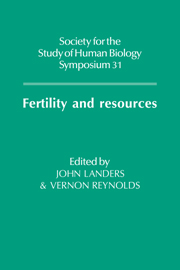Book contents
- Frontmatter
- Contents
- List of contributors
- 1 Introduction
- 2 Environmental and social determinants of fecundity in primates
- 3 Biological aspects of fertility among Third World populations
- 4 A preliminary report on fertility and socio-economic changes in two Papua New Guinea communities
- 5 The cultural context of fertility transition in immigrant Mennonites
- 6 Inter-relationships between consanguinity, religion and fertility in Karnataka, South India
- 7 Resources and the fertility transition in the countryside of England and Wales
- 8 Fertility decline and birth spacing among London Quakers
- 9 Population growth, innovation and resource exploitation
- 10 Fertility decline in developing countries: the roles of economic modernization, culture and Government interventions
- 11 Understanding recent fertility trends in the Third World
- 12 Monogamy, landed property and demographic regimes in pre-industrial Europe: regional contrasts and temporal stabilities
- Index
12 - Monogamy, landed property and demographic regimes in pre-industrial Europe: regional contrasts and temporal stabilities
Published online by Cambridge University Press: 13 March 2010
- Frontmatter
- Contents
- List of contributors
- 1 Introduction
- 2 Environmental and social determinants of fecundity in primates
- 3 Biological aspects of fertility among Third World populations
- 4 A preliminary report on fertility and socio-economic changes in two Papua New Guinea communities
- 5 The cultural context of fertility transition in immigrant Mennonites
- 6 Inter-relationships between consanguinity, religion and fertility in Karnataka, South India
- 7 Resources and the fertility transition in the countryside of England and Wales
- 8 Fertility decline and birth spacing among London Quakers
- 9 Population growth, innovation and resource exploitation
- 10 Fertility decline in developing countries: the roles of economic modernization, culture and Government interventions
- 11 Understanding recent fertility trends in the Third World
- 12 Monogamy, landed property and demographic regimes in pre-industrial Europe: regional contrasts and temporal stabilities
- Index
Summary
In any consideration of possible relationships between monogamous marriage, resource exploitation and fertility in the European past, generalizations are hard to make with confidence. However, Europe provides an interesting milieu within which to review certain issues to do with these inter-connections because it is the continent which supposedly fostered the emergence of a marital regime that is believed to have been highly distinctive, perhaps unique, within a wider world context. Although Malthus had noted this possibility with regard to European society somewhat hesitantly and rather belatedly in his own writings, it was left to John Hajnal (1965) in a classic essay published a quarter of a century ago to specify these unique features with geographical, if not chronological precision. Europe's most distinctive feature with regard to marital behaviour lay in the fact that women married, as E. A. Wrigley (1985: p. 3) has succinctly noted, ‘little and late, by comparison with other major cultures whose characteristics are known – India, China, Muslim countries or the Roman World …’ In these last-mentioned societies marriage for women began at, or close to, the arrival of sexual maturity and it was to a considerable degree regarded as improper both for the girl and her family if she were not married at or soon after puberty. In such circumstances marriage was pre-determined by a biological process or largely invariant moment in the life-course and was in no sense a ‘moveable feast’. What is more, only a handful of women remained permanently unmarried; only those who suffered from severe mental or physical handicap would be likely to do so.
- Type
- Chapter
- Information
- Fertility and Resources , pp. 164 - 188Publisher: Cambridge University PressPrint publication year: 1990
- 8
- Cited by



